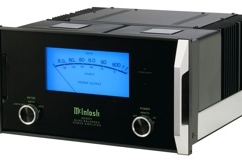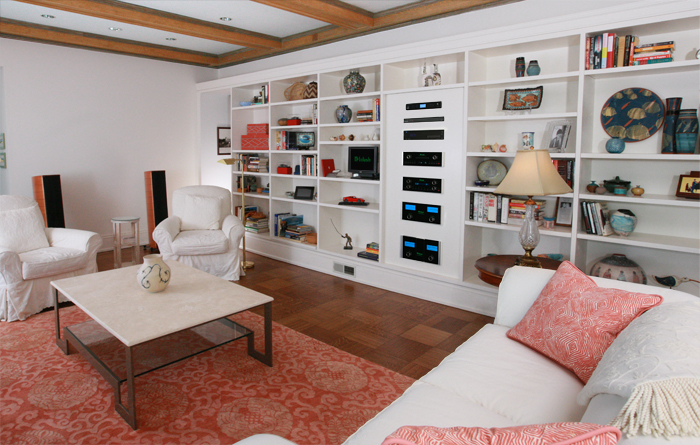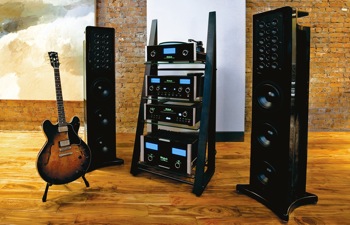Articles and News
EXCLUSIVE! NOW HEAR THIS: WHAT FINE AUDIO CAN TEACH FINE JEWELERS ABOUT SELLING TO GEN-Y | April 27, 2011 (0 comments)

Merrick, NY—Name a luxury industry that has to shed a staid reputation quickly enough to grab the interest of a new generation of consumers at the same time it’s recovering from the toughest economy its current generation has ever experienced
If you guessed fine jewelry, you’re right. And if you guessed fine audio, you’re right again. Despite competing for the same discretionary share of wallet, the two industries face remarkably similar challenges as the consumer marketplace gradually shifts from aging Boomers to rising Millennials.
Linda Malias Passaro is the global vice president of sales and marketing for Binghamton, NY-based McIntosh Industries, a manufacturer of prestige audio equipment. But prior to joining McIntosh, Passaro spent more than 20 years in the fine jewelry and watch industry, first as a brand manager for De Beers at both N.W. Ayer and J. Walter Thompson and later managing three luxury watch brands, Baume & Mercier, Montblanc, and Longines. At De Beers, she was responsible for total integration of marketing for the trade, working with the Diamond Promotion Service, the Diamond Information Center, and with the advertising agencies that actually created the consumer-facing commercials and marketing.
She also spent two years at Simmons Jewelry Group, developing the Green Bracelet initiative for the Diamond Empowerment Fund.
Now, as head of sales and marketing for McIntosh, she’s tasked with growing the brand and ensuring its vitality among the next generation of luxury audio consumers. In an exclusive interview with The Centurion, Passaro tells how both jewelers and audio engineers can lead the instant-gratification iPod generation to want quality and lasting value.
The Centurion: What, if any, similarities exist between prestige audio and prestige jewelry and watches?
Linda Malias Passaro: When you talk about luxury in any category, you’re first and foremost talking about hand craftsmanship. When a skilled craftsman makes the product by hand, it’s going to last longer, work better, and there’s a certain cachet to the consumer being in the know. It’s going to be handed down from generation to generation. It’s got lasting intrinsic value, and it’s got lasting emotional value. It’s why watch companies show videos of their workshops in Switzerland and why we’re still servicing McIntosh equipment from the 1940s that has been passed down through generations.
But there’s also a need to balance your history and heritage with your future vision. How do you take an established brand and make it modern? If the average age of your customer is 55 and aging, how are you going to bring in the next generation? It doesn’t matter that you’ve been around since 1865; it’s ‘what have you done for me lately?’ Gen-Y is very immediate, very much about living in the moment. They want to be humored and entertained. This is a text generation. You don’t have to talk in text but keep it short and relevant.
TC: What is one of your biggest challenges in marketing high-end audio?
LMP: Teaching quality to consumers that grew up on compressed sound [downloads].I think the jewelry industry has done an outstanding job in creating tools to define quality. For example, a grading scale where you can easily see specific markers that define why this stone is better quality than that stone. It’s much harder to teach an audio newbie what to listen for. I hope the audio industry can create a scale for sound much like GIA did for diamonds.
TC: Jewelers are worried that Gen-Y consumers are more focused on funky design than the intrinsic value of precious materials, so they’re searching for ways to get the value message to resonate. How will you teach the iPod generation to appreciate the subtle nuances of fine audio?
LMP: For us, it’s an emotional appeal to young consumers who are passionate about music. Perhaps they’re musicians themselves. If they don’t care that much about their music, they’re not going to care about how they listen to it, but if music is their passion, then it’s an emotional connection, and equipment is merely how it’s expressed. You sell lifestyle and quality in one package, not as an either-or choice. An iPod is for the on-the-go part of your life, but fine audio is your passion at home with family and friends.
TC: So it’s kind of like diamonds as an expression of love.
LMP: Yes, the commonality is triggering the senses. In fine jewelry and watches, there’s the experience of how you feel wearing it and when others appreciate it. But with fine audio, you can’t wear it. You have to bring your family and friends into your home to experience it. McIntosh wants to be there when you share that passion with your family and friends. We want people to say, ‘I feel like I’m in a recording studio,’ because the sound is so pure, and you don’t get that with compressed music.
It’s all about triggering the buy, getting the customer to go to the shopping cart.
TC: Can this generation of consumers even afford the product yet?
LMP: There’s a definite need for a collection of product whose style and price appeals to the new customer—and then you have to have a place for them to graduate to. For prestige audio, the next generation isn’t 18-24, it’s more like 25-40, but we needed price points under $10,000. We’ve done that with our Manhattan collection, which is a complete plug-and-play system that retails for $7,500.
TC: What else is necessary to develop the next generation of consumers?
LMP: Design is really important. This is a very visual generation. You have to speak to the younger consumer with design that inspires. Younger consumers are starting to look at fine jewelry as a fashion item. For audio, it has to be attractive enough to display, not hide in a closet in the man cave.

A McIntosh installation in a customer's home.
Our new website has much more beauty and lifestyle imagery, not just tech specs. It’s about how you live and experience your music—but also that McIntosh equipment is what professionals use in their studios, so if you can afford it, why wouldn’t you have it? It’s like a Viking stove—it’s what professional chefs use, so [the implication is] it’s what you need to get the same results.
TC: How do you even reach the target audience in the first place?
You have to communicate in their space. It’s very much about being in social [media] and finding the influencers. People still like to be in the know about things, and have things that distinguish them from the pack. Companies that educate in the right tone of voice in the right medium will succeed. People are buying online, and they’re buying luxury online, so we have to deal with that.
It may mean new relationships or new business models. People who are into luxury are into luxury, period. They like fine food, fine wine, fine cars, et cetera, not just one category. So maybe we should rethink the retail experience. For example, menswear designer John Varvatos has our Manhattan collection in four of his stores, and it’s not just decorative, it’s for sale. It’s selling so well he’s planning on putting it in his new South Coast Plaza (CA) store when it opens.
So why not put a McIntosh system next to the watch counter? We’re actually discussing a joint promotion with a jeweler right now.
We have two shop-in-shop experience centers where we set the entire system up like a home theater in an audio store. There’s one on the West Coast and one on the East Coast. We’ve also had pop-up shops in places where high net worth individuals (HNWI) go to play, such as the RM luxury auto auction in Florida. We’ve gotten many HNWI to give us personal data and make an appointment to have a specialist come to their house for a demo, just because we’re there when they’re shopping for a car—and they’re not really thinking about audio! We’ll be at the Sonoma Jazz Festival with Wine Spectator magazine, and so on. We’re also working with the recording industry—we’re talking to Warner Bros. right now—about how we can get the next generation to care about quality.

McIntosh equipment with a guitar evokes the image of a professional recording studio.
TC: What about selling online?
LMP: The first thing people do when they’re considering a purchase is research—usually online. It’s a bigger challenge for sound online than jewelry or watches, which are visual. Sound on a computer is terrible. I also learned the purchase consideration time for audio is very long—sometimes as much as nine months to a year between first research and final purchase.
So will we continue to push through dealers or sell online? Maybe both, but we’ll always need a network of dealers. We have installation, fine-tuning, and other service that has to be done in person and on site.
TC: You need to get the next generation to care about sound quality. And jewelers need the next generation to care about intrinsic value as much as fashion appeal. How can both industries each ensure there’s an audience for our products?
LMP: I think it’s an opportunity for everyone to come together. The associations [in each industry] need to take a larger role, and we all need to think more like a consumer and do more market research. It doesn’t mean you’re weak, it means you’re going to be more on target with your product.
People feel good about luxury, about having something that others don’t. I think it’s gone back to what it used to be; it’s not as commoditized.







